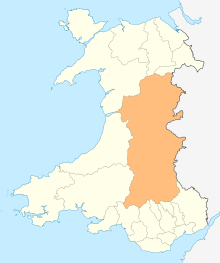Llansantffraed
Llansantffraed (Llansantffraed-juxta-Usk)[2] is a parish in the community of Talybont-on-Usk in Powys, Wales near Brecon. The benefice of Llansantffraed with Llanrhystud and Llanddeiniol falls within the diocese of St David's in the Church in Wales.[3]
.jpg)
| Llansantffraed, Talybont-on-Usk | |
|---|---|
 Llansantffraed, Talybont-on-Usk Location within Powys | |
| Population | 1,422 (2011)[1] |
| OS grid reference | SO123235 |
| Community | |
| Principal area | |
| Ceremonial county | |
| Country | Wales |
| Sovereign state | United Kingdom |
| Post town | BRECON |
| Postcode district | LD3 |
| Dialling code | 01874 |
| Police | Dyfed-Powys |
| Fire | Mid and West Wales |
| Ambulance | Welsh |
| UK Parliament | |
| Senedd Cymru – Welsh Parliament |
|
The church of St Ffraid is a grade II* listed building.[4] It was largely restored in 1690 and was completely rebuilt in 1885 by the architect Stephen W. Williams.[5]
The parish is the burial place of the poet Henry Vaughan (1621–1695), who was born in the hamlet of Scethrog within the parish. Vaughan's grave in the churchyard, on the slopes of a hill known as Allt-yr-Esgair or simply The Allt,[6] overlooks the River Usk. The poets Siegfried Sassoon, Roland Mathias, Brian Morris and Anne Cluysenaar were all inspired to write poems by their visits to the grave. Sassoon's "At the Grave of Henry Vaughan" is the best-known of these and is read every year at the graveside following the Vaughan memorial service.[7]
Another grave of note in the churchyard is a Grade II listed tomb erected for the Gwynne-Holford family, residents of nearby Buckland Hall.[8] The family included Colonel James Gwynne-Holford, Conservative MP for Brecon (died 1886).[9]
Henry Vaughan's twin brother, Thomas Vaughan, became rector of Llansantffraed in about 1644.[10] He was forced to vacate the position in 1650, on grounds that included his having been on the Royalist side during the English Civil War.[11]
The Old Rectory, which stands close by the church to the northwest, is a Grade II Listed Building, with an estimated date of late 18th century. It is thought to have been built as a hunting lodge for the Buckland estate and converted into a rectory in the 19th century, but was released by the church during the 1950s. It later became a guest house.[12]
Governance
An electoral ward with the same name exists. The population of this ward at the 2011 census was 1,880.[13]
References
- "Community population 2015". Retrieved 13 November 2015.
- Breconshire. CUP Archive. pp. 163–. GGKEY:QG71J8NPWLF.
- "Benefice of Llansantffraed with Llanrhystud and Llanddeiniol". Church in Wales. Retrieved 28 April 2016.
- "Church of St Ffraid, Llansantffraid". British Listed Buildings. Retrieved 15 December 2013.
- "Llanigon - Llansantffraed". Powys Local History Encyclopedia. Retrieved 28 April 2016.
- Edward W. Williamson (1953). Henry Vaughan.
- "Henry Vaughan, Poet and Physician: Grave and heritage at Llansantffraed, Brecknockshire". Brecknock Society and Museum Friends. Retrieved 28 April 2016.
- "Brecknockshire Churches Survey". Clwyd-Powys Archaeological Trust. Retrieved 2 October 2016.
- "Gwynne Holford Monument in the churchyard to SW of Church of St Ffraed, Talybont-on-Usk". British Listed Buildings. Retrieved 2 October 2016.
- "Landscape and Literature". David Gill. Retrieved 28 April 2016.
- Siberry, Elizabeth; Wilcher, Robert (2016). Henry Vaughan and the Usk Valley. Logaston Press. p. 30. ISBN 9781910839027.
- "The Old Rectory, Talybont-on-Usk". British Listed Buildings. Retrieved 28 April 2016.
- "Ward population 2011". Retrieved 13 November 2015.
External links
- Photos of Llansantffraed and surrounding area at geograph.org.uk
